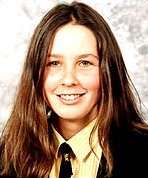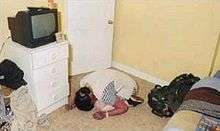Rachel Whitear
| Rachel Whitear | |
|---|---|
 | |
| Born |
6 February 1979 Weymouth, Dorset[1] |
| Died |
10 May 2000 (aged 21) Exmouth, Devon |
| Nationality | English |
| Occupation | former student; bar worker, shop worker |
| Known for | Death following heroin use |
Rachel Jayne Whitear[2] (6 February 1979 – 10 May 2000) was a young woman from Withington, Herefordshire, England, who died in Exmouth, Devon, following a heroin overdose. Her death in May 2000 led to a large-scale anti-drugs campaign in Britain, particularly in secondary schools, when her parents allowed the publication of a police photograph of her body, collapsed on the floor and discoloured. The school campaign was centered on a 22-minute video called Rachel's Story.[1] The campaign was compared to the anti-ecstasy drive undertaken after the death of English school girl Leah Betts in 1995 and a parallel incident culminating in the death of Australian schoolgirl Anna Wood in Sydney.
Life
Born in Weymouth, Dorset, in 1979, Whitear moved to Herefordshire at an early age and grew up there.[1] In August 1999 she began studying at the University of Bath, but had dropped out and moved to Exmouth by early January 2000. She had jobs in a bar in Bath and a shop in Exmouth. Whitear had a history of substance abuse from the age of 14, which progressed to heroin addiction. She had suffered overdoses in early 2000 but by the time of her death had been engaging with drug counselling and was seeking employment and medical treatment.[3]
Death

Whitear was 21 when she died, having been found in her bedsit at 4 Pound Street, Exmouth, by her landlord, two days after she was last seen alive.[3] The image portrayed in the campaigns was that of a normal, everyday girl, with the message that it could happen to anyone.
Case history
The initial police investigation was criticised for a failure to observe correct procedure, and the conclusions of the investigation were questioned. Fingerprints were not taken until two weeks after police were first called to the scene and officers from the Devon and Cornwall Police force originally investigated the death without a post-mortem examination.[4] Toxicology later revealed that the level of heroin in Whitear's bloodstream was 0.05 micrograms per millilitre, one third of the 0.15 μg/ml generally considered to be fatal.[5] Because the case seemed to have been solved, no post-mortem examination was ordered. Two men were arrested in connection with her death, but were released without charge.
Exhumation
Whitear's body was exhumed on 23 March 2004, and a second investigation, by Wiltshire Police, this time including a post-mortem. The inquest returned an open verdict. In October 2006, the High Court overturned the decision of Dr Elizabeth Earland, Exeter and Greater Devon District Coroner, not to grant a request for a new inquest, after evidence from Russell Fortt, counsel for Chief Superintendent Paul Howlett of Wiltshire Police, told the court there had been a "highly material failure to carry out reliable toxicology tests which was compounded by the failure to carry out a post-mortem". He said that a significant body of evidence now existed which was not previously before the coroner. Additionally, there has been speculation that Whitear may have been killed by her boyfriend.[6]
Controversies
A painting of Whitear by Stella Vine, showing her with blood coming from her mouth, caused controversy during the second investigation when the police backed the calls of Whitear's parents for it not to be part of the Saatchi Gallery exhibition New Blood. Despite the controversy, it was not withdrawn.[7]
In 2008 her parents were reported to be considering legal action against the British National Party (BNP), who used the photograph of Rachel's body in a political leaflet.[8] The BNP refused to apologise for the use of the image.
References
- 1 2 3 Smart, Chris (2002). Rachel's Story (motion picture). Silva Productions. Retrieved 7 December 2016.
- ↑ http://www.ipcc.gov.uk/news/Pages/pr170708_whitear.aspx
- 1 2 Howlett, Paul. "Case Summary: Operation Helix: An investigation into the death of Rachel Whitear" (PDF). Independent Police Complaints Commission. Wiltshire Police Professional Standards Department. Retrieved 7 December 2016.
- ↑ "Fresh inquest into Whitear death" at BBC News
- ↑ Addict's Body to be Exhumed for New Tests
- ↑ "Rachel 'killed by Jilted Lover'", The Sunday Times, October 29, 2006
- ↑ 16 March 2004 "Rachel portrait 'appals' family" at BBC News.
- ↑ "Heroin photo used in BNP leaflet". BBC News. 10 March 2008. Retrieved 22 May 2010.
External links
- 1 March 2002. "Heroin victim's death used as warning" at BBC News. Accessed 21 November 2005.
- 14 February 2004 "Addict's body to be exhumed for new tests" at Guardian Unlimited. Accessed 22 November 2005.
- 3 August 2004. Booth, Jenny. "No third party involved in Rachel's heroin death" at The Times Online. Accessed 21 November 2005.
- 4 August 2004. Glendinning, Lee. "No third party involved in Rachel Whitear death" at The Guardian. Accessed 21 November 2005.
- http://www2.correioweb.com.br/cw/2002-03-02/fotos/PRI-0203-0110.JPG
- 14 September 2007 Rachel 'may not have died alone'